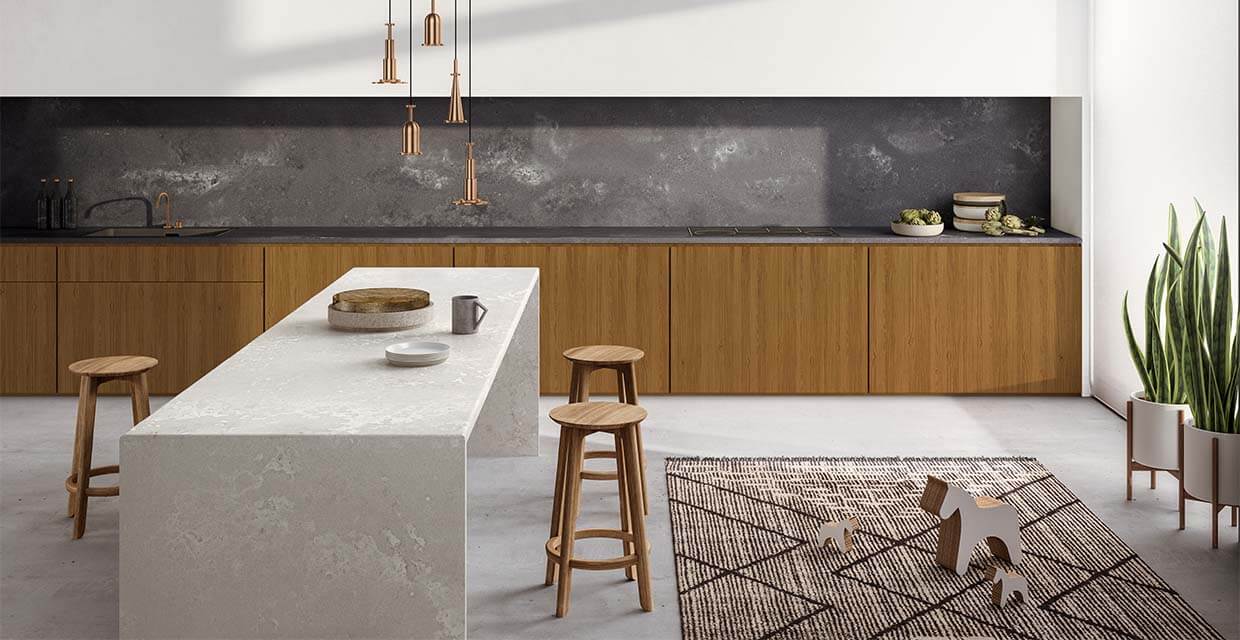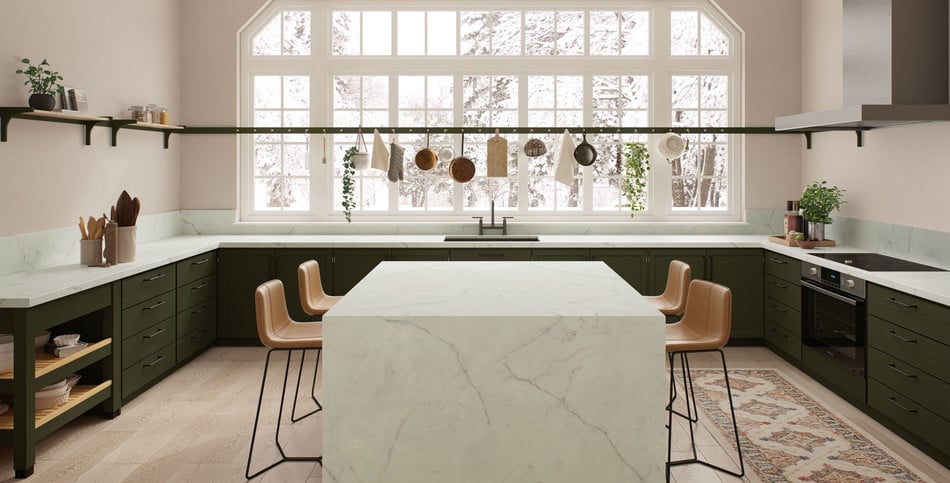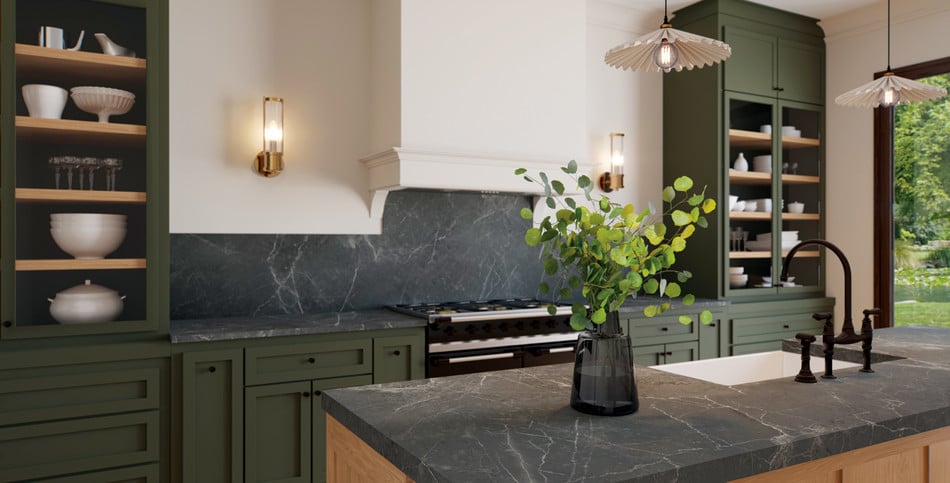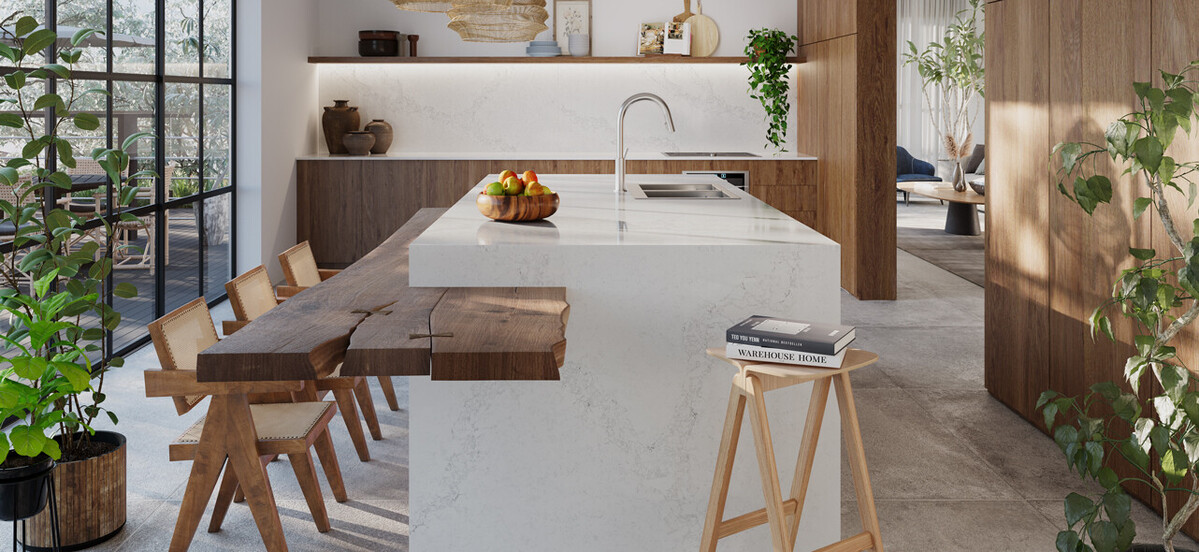
It’s often said that worktops are one of the hardest-working tools in your kitchen, getting exposed to foods and liquid spills on a daily basis, as well as a multitude of utensils and the latest technology. Therefore, your new worktop needs to be resilient and able to withstand everything that gets thrown at it.
What to consider when choosing a new worktop
Given that your new kitchen worktop is going to get used daily and potentially get very messy, it’s important to consider how easy it is to clean your worktop and keep it in top condition. At Caesarstone, all of our worktops are incredibly durable and nonporous, so they’re virtually maintenance-free. Simple daily cleaning means they stay beautiful and usable for many years to come.
Then there’s style. Trends come and go, but style endures. There are, of course, some prevailing favourites when it comes to choosing kitchen worktops, and many kitchen designs now also use your chosen kitchen worktop throughout the design – including upstands, splashbacks, over large island units and to the floor via waterfall ends. Because of this, your selected surface plays the starring role in the overall look of the finished space. No wonder people tend to start with the work surface when designing their new kitchen, and it now represents around 20-25% of the overall cost.
The aim is simple: to pick a robust and long-lasting, functional and easy-to-maintain worktop material that is beautiful and transforms a kitchen space from so-so into a jaw-dropper.
Marble Worktops
Considered classic and elegant, marble worktops are predominantly known for being white with high contrast veins. However, they are also available in greens, greys and blacks, with far more subtle tonal patterns, depending on the worktop.
Benefits of marble worktops
Popular for many years, marble is rarely out of style and is considered a timeless addition to your kitchen. Plus, embodying classic elegance, marble delivers real opulence to interior design schemes, perfect for many kitchen styles. Marble worktops are a popular choice for kitchens as they are both heat-resistant and naturally cool. This makes them ideal for the kitchen environment and for keen bakers working with dough.
 A brilliant alternative to marble is our 5131 Calacatta Nuvo Fusion worktop
A brilliant alternative to marble is our 5131 Calacatta Nuvo Fusion worktop
Drawbacks of marble worktops
Unfortunately, there are well-documented limitations with marble. One of the main issues is that it's relatively soft, making it susceptible to scratching, chipping and cracking following heavier impacts like dropping a heavy-bottomed pan.
Marble is also porous, which makes staining an issue. Red wine, lemon juice and turmeric are all everyday items that are going to cause problems for your marble tops, and some harsher cleaning products do more harm than good. Once damaged, marble worktops can be expensive and sometimes impossible to fix. Its porous nature can also make it a haven for bacteria, although a good, twice-yearly sealing can help reduce this chance, though it will incur additional ongoing costs throughout the lifespan of your worktop.
Granite Worktops
Granite is another popular worktop type that many people consider when designing a new kitchen – this is thanks to its durability and timeless beauty.
Benefits of granite worktops
Granite is traditionally more widespread as a material for kitchen surfaces than marble, and is slightly less porous, generally requiring sealing once a year, which adds a strong protective layer and protects the worktop, although it does mean ongoing costs of installation. It is also harder than marble, making it less likely to get damaged during everyday use.
 A fantastic alternative to granite is our 6046 Moorland Fog quartz worktop
A fantastic alternative to granite is our 6046 Moorland Fog quartz worktop
Drawbacks of granite worktops
However, as a natural product quarried from the earth, the strength and structural integrity of granite can vary, with some slabs more susceptible to damage than others due to hidden fissures and flaws. Each slab is also unique and can vary in appearance, meaning that what you see and what you buy can be different.
Quartz Worktops
Quartz worktops, also known as engineered stone or composite stone worktops, have grown into one of the most popular kitchen worktop choices thanks to their high-quality look and durable nature.
Benefits of quartz worktops
Manufactured primarily from natural quartz minerals, quartz worktops are scratch-resistant and stain-resistant, making them ideal for everyday kitchen use. Because of this, quartz surfaces are also virtually maintenance-free, requiring little daily maintenance with a splash of soapy water and a damp cloth.
Our quartz worktops also have non-porous properties, which means they never need sealing and they remain one of the most hygienic surfaces available for kitchen spaces. We also offer a lifetime warranty, so you can have complete peace of mind that you can enjoy your Caesarstone worktop for many years to come.
Where quartz really comes into its own is in terms of choice. Quartz surfaces are available in a huge range of colours and patterns, with the high-end brands designing surfaces that are indistinguishable from natural marble and granite. Advances in quartz technology have also seen the development of finishes with unique textural movement, capturing the look and feel of surfaces such as poured plasters or raw concretes, ideal for industrial or urban-themed interiors.

A perfect alternative to a poured concrete worktop is our 4023 Topus Concrete quartz worktop
Drawbacks of quartz worktops
A downside of quartz is that it shouldn’t be used outside as it can be damaged by the elements, so if you’re looking to use the same worktop material inside and out, we recommend choosing porcelain as it's perfect for both spaces. Its blend of natural ingredients means it’s UV-resistant, making it the ideal surface for your new outdoor kitchen.
Another drawback of quartz is the number of unbranded and unknown quartz worktop suppliers on the market. Buying these unbranded quartz surfaces is a major gamble as they are not manufactured to the same standards as branded worktops like Caesarstone. Some of the main downfalls of unknown quartz include inconsistent quality due to a lower percentage of quartz and higher resin content, leading to reduced resistance to scratches, stains, and heat. You also face a lack of reliable warranties and potential safety issues, meaning the upfront savings can quickly turn into long-term replacement costs. Buying from Caesarstone means you get a high-quality, reliable and durable worktop that will last you for years to come, backed by our lifetime warranty.
Alternative Caesarstone worktop materials
If you’re looking for different worktop materials to marble, granite and quartz, we also offer a few other choices: ICON, mineral and porcelain, which we’ve already touched on above. These alternative choices offer different designs and benefits, so depending on your needs, we have a worktop for you.
ICON
New in 2025, Caesarstone ICON is an advanced fusion surface that brings style and sustainability. Made with around 80% recycled materials and crystalline silica-free*, our new iconic designs add an extra luxurious and stylish feel to your space. As pioneers of the industry, we will continue to grow our ICON range and transition existing designs into this new technology so you can continue to enjoy the same benefits of Caesarstone as you have always done.
Explore our ICON collection ->
Mineral
As pioneers in the industry with over 35 years of experience, we’re pleased to have brought the next generation of worktops to market with our Caesarstone Mineral worktops. These premium, sustainable surfaces are made with a unique blend of materials, giving them enduring quality and making them both easy to maintain and environmentally friendly.
Explore our mineral collection ->
Porcelain
Caesarstone Porcelain has brilliant functionality and design by introducing three innovative properties that deliver a high degree of durability, strength and style. They are incredibly resistant to scratches, pressure, rupture and high temperatures.
Our unique designs also allow for striking colour schemes, bolder veins, palpable textures, and magnified patterns. Therefore, you can have a kitchen surface that is simple to care for and maintain in a range of beautiful patterns.
Explore our porcelain collection ->
Ready to design your dream kitchen?
There are many different types of kitchen worktops to choose from when designing your dream kitchen, and you should consider all your options before selecting the best one for you. We recommend always buying from a reputable brand such as Caesarstone so you can enjoy your worktop for many years to come.
All of our worktops are engineered to be durable, resistant to scratches and easy to maintain, so you can focus on enjoying your new kitchen, not worrying about how to clean it. We also offer a range of designs to suit any kitchen type, from industrial concretes and black veined worktops to marble-style and beige worktops. So, no matter whether you choose ICON, mineral, quartz or porcelain, we have the worktop for you.
To truly appreciate the stunning aesthetics and craftsmanship of Caesarstone’s surfaces, why not experience them for yourself? Request a sample today and take the first step toward creating your dream kitchen with Caesarstone.
*May contain traces of up to 1% crystalline silica.



